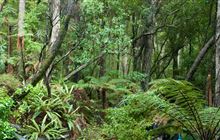Bid to regain pest-free island for nature
Introduction
DOC is planning to remove rats from Ulva Island/Te Wharawhara to return the sanctuary to its former pest-free status this winter.Date: 26 July 2023
Ulva Island, near Rakiura/Stewart Island, is home to vulnerable native species like tieke/South Island saddleback, mohua/yellowhead, titipounamu/rifleman, and South Island kākā.
It was first declared pest-free in 1996 but its proximity to Rakiura – just 780 m at the closest point – means it’s vulnerable to reinvasion.
DOC Rakiura Operations Manager Alex Macleod says Ulva Island is protected by a dense network of traps, which typically hold the line against rats that have made the swim. However, large forest fruiting and seeding events on Rakiura in 2021 and 2022 caused rat numbers to spike and increased invasion pressure.
“Unfortunately, a number of rats were able to slip past the island’s line of defence and start multiplying.”
DOC began an incursion response including deploying extra traps, hand laying bait, and using rodent detection dogs – but by May 2022 it became clear rats had become too widespread to remove by these methods.
“We went out to the community to discuss response options and decided to progress with a re-eradication plan, which was well supported.
“Ulva Island is a haven for many species and a place close to people’s hearts – they come here to see what Aotearoa could be like without introduced predators. To preserve that, we need to undertake an aerial eradication,” says Alex Macleod.
The operation, using brodifacoum, was planned to start from the week of 17 July and will go ahead when weather and logistics allow. It will include two applications of bait at least 10 days apart and each application will take a day. Public access to the island will be restricted for the days of aerial baiting.
DOC has also been doing work to upgrade the island’s biosecurity system to improve interception of pest invaders, Alex Macleod says.
“This includes using new tools like trail cameras, more traps, more frequent trap checks and a rearranged grid increasing detection and control devices in the coastal areas where the pests typically first arrive.
“Until we can achieve a predator-free Rakiura, Ulva Island will be vulnerable to reinvasion by rats and careful ongoing management is required.”
The new biosecurity system will be activated immediately after the operation and intense monitoring over several months will be undertaken to determine whether rats have been successfully eradicated.
Contact
For media enquiries contact:
Email: media@doc.govt.nz

